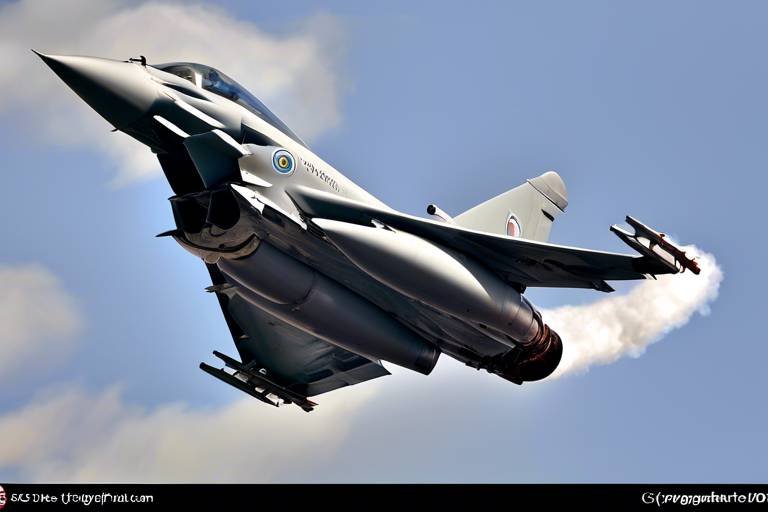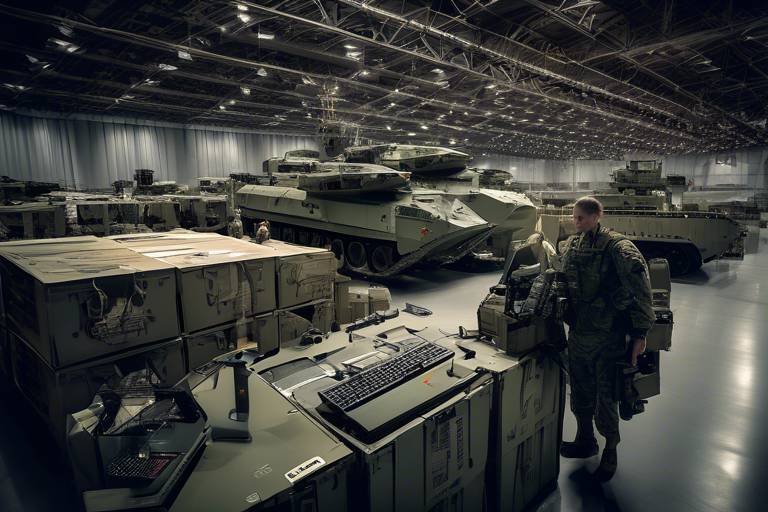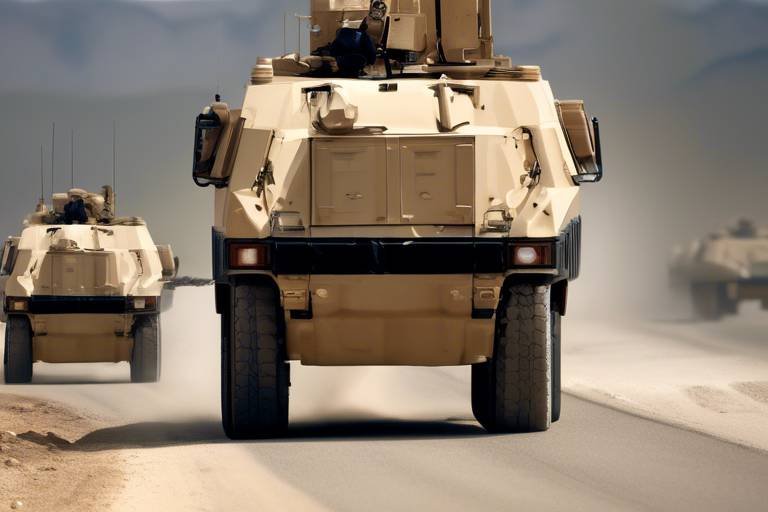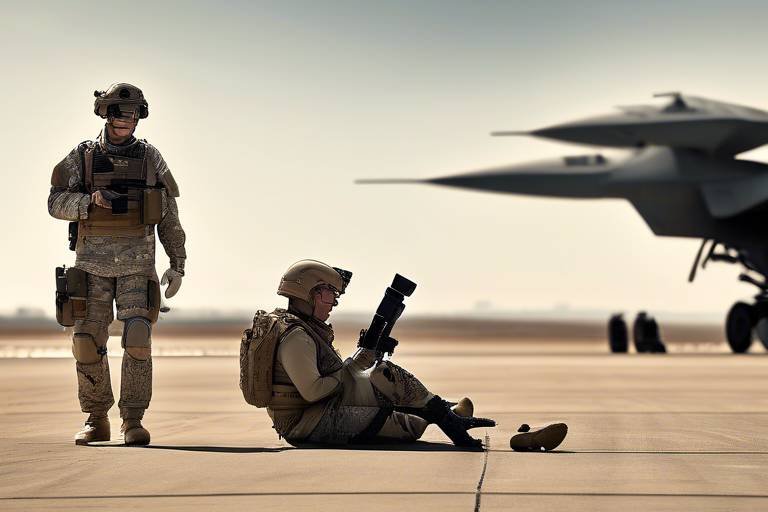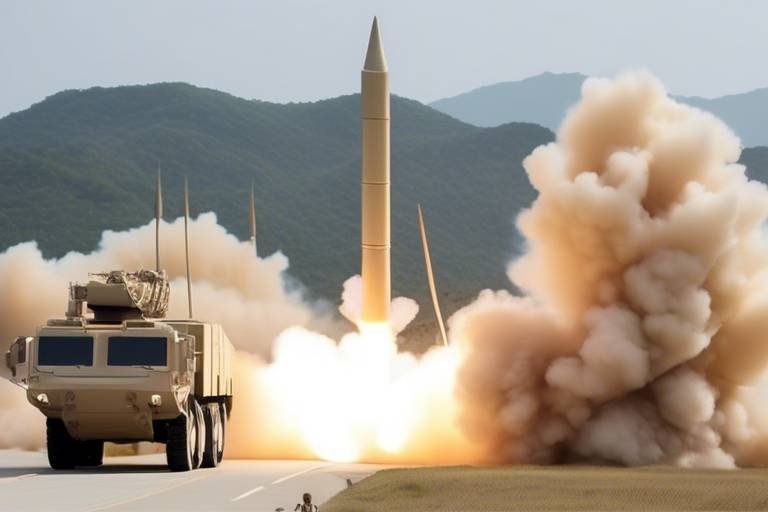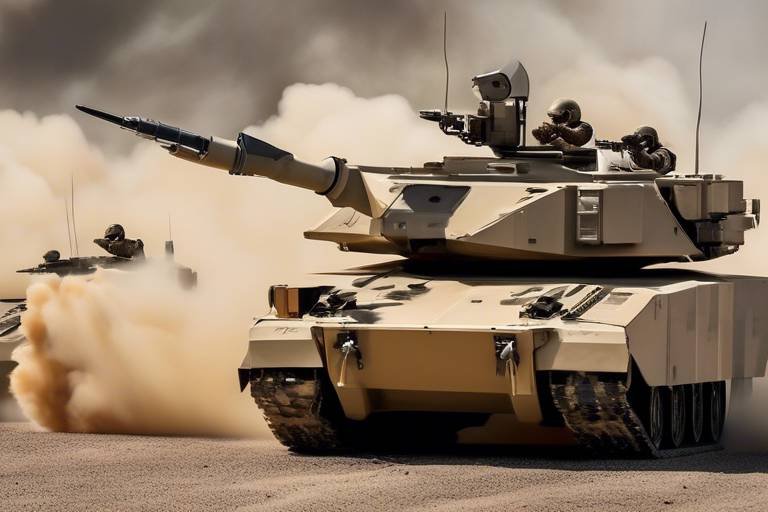The Future of Military Airlift: Advancements in Cargo Aircraft
The landscape of military airlift is evolving at an unprecedented pace, driven by the need for greater efficiency and operational flexibility. As global conflicts become more complex, the demand for rapid deployment and logistics support has never been more critical. This article dives deep into the latest advancements in military cargo aircraft, focusing on the innovative technologies, design improvements, and their implications for future military operations and logistics. With the advent of cutting-edge technologies, the military is set to revolutionize the way it conducts airlift missions, ensuring that troops and supplies reach their destinations faster and more efficiently than ever before.
Innovative technologies are at the forefront of transforming cargo aircraft. The integration of automation, artificial intelligence (AI), and advanced materials is not just enhancing efficiency; it’s also significantly reducing costs and improving operational capabilities for military airlift missions. Imagine a cargo aircraft that can autonomously navigate through adverse weather conditions, adapting its flight path in real-time. This level of automation not only increases the safety of the mission but also frees up pilots to focus on strategic decision-making rather than routine operations.
Furthermore, advanced materials such as lightweight composites are making aircraft not only lighter but also stronger. This means that military cargo aircraft can carry heavier loads over longer distances without compromising on fuel efficiency. In essence, the future of military airlift is being shaped by technologies that promise to make airlift operations faster, safer, and more cost-effective.
Modern cargo aircraft are being designed with a keen focus on enhanced aerodynamics and fuel efficiency. These designs are not just about aesthetics; they are a response to the increasing demands of military logistics, ensuring that aircraft can operate effectively in various environments. For instance, the latest designs incorporate features that reduce drag and improve lift, enabling them to take off and land in shorter distances. This is particularly beneficial for operations in remote or austere locations where traditional runways may not be available.
The integration of hybrid and electric propulsion systems is revolutionizing military airlift. These systems promise not only reduced emissions but also lower operating costs, all while maintaining the power needed for heavy-lift operations. As militaries around the world strive to become more environmentally friendly, the move towards hybrid and electric technologies is a game-changer. Imagine a fleet of cargo aircraft that can operate silently, reducing their detection risk while also being kinder to the planet.
Sustainable aviation fuel (SAF) is gaining traction in military operations, offering a greener alternative to traditional fuels. SAF can significantly lower carbon footprints and enhance the sustainability of military airlift missions. By incorporating SAF into their operations, military forces can not only comply with environmental regulations but also improve their public image. This shift towards sustainability is not merely a trend; it’s a necessity for future military operations.
Advancements in avionics and navigation systems are improving the accuracy and safety of cargo aircraft. Enhanced situational awareness provided by modern avionics allows pilots to make informed decisions in real-time, especially during complex missions. Automated systems are also facilitating better decision-making, minimizing human error, and ensuring that missions are completed efficiently and safely.
Modular cargo systems provide flexibility and efficiency in transporting various types of cargo. These systems can be quickly reconfigured to meet diverse mission requirements, enhancing logistical support for military operations. Whether it’s transporting humanitarian aid, military supplies, or personnel, modular systems allow for rapid adjustments, ensuring that the right resources are delivered where and when they are needed.
The integration of unmanned aerial vehicles (UAVs) into military airlift operations is another exciting development. Drones can supplement traditional cargo aircraft, offering unique capabilities for delivering supplies in challenging environments. Imagine a scenario where a drone can navigate through hostile territory to deliver critical supplies while keeping the crewed aircraft at a safe distance. This capability not only enhances operational effectiveness but also reduces risk to personnel.
While UAVs offer significant advantages, integrating them into existing airlift operations presents challenges. Issues such as airspace management, regulatory compliance, and operational coordination must be addressed for successful implementation. As military planners look towards the future, overcoming these challenges will be crucial for fully realizing the potential of drones in airlift operations.
The future of military airlift will be shaped by ongoing advancements in technology, evolving mission requirements, and strategic partnerships. Understanding these trends will be crucial for military planners and logistics personnel. As we look ahead, the military must be prepared to adapt to new technologies and methodologies that will redefine how airlift operations are conducted.
- What are the main advancements in military cargo aircraft?
Recent advancements include automation, AI integration, hybrid propulsion systems, and modular cargo systems. - How do sustainable aviation fuels impact military operations?
SAF reduces carbon footprints and enhances the sustainability of military airlift missions. - What role do drones play in military airlift?
Drones supplement traditional aircraft, providing unique capabilities for supply delivery in challenging environments.

Emerging Technologies in Cargo Aircraft
The landscape of military airlift is undergoing a dramatic transformation, thanks to a wave of emerging technologies that are reshaping cargo aircraft. As the demands of modern warfare evolve, military forces are increasingly turning to innovative solutions that enhance efficiency, reduce operational costs, and improve logistical capabilities. One of the most significant advancements is the integration of automation and artificial intelligence (AI) within cargo aircraft systems. These technologies not only streamline operations but also allow for real-time data analysis, enabling smarter decision-making during missions.
Consider the impact of AI on flight operations. Imagine an aircraft that can autonomously adjust its flight path based on weather conditions or potential threats, minimizing human error and enhancing safety. Such capabilities are no longer just a dream; they are becoming a reality. Moreover, the use of advanced materials in aircraft design is another game-changer. Lightweight yet durable composites are being utilized to construct airframes, which not only improve fuel efficiency but also increase payload capacity. This means military cargo aircraft can carry more supplies over longer distances without compromising performance.
Furthermore, the advent of smart sensors is revolutionizing how cargo aircraft operate. These sensors provide critical information about the aircraft's performance and the condition of the cargo being transported. For instance, they can monitor temperature-sensitive supplies, ensuring that medical supplies or other perishable goods arrive at their destination in optimal condition. This level of monitoring is essential for maintaining the integrity of sensitive materials, especially in military operations where timing is crucial.
Another exciting development is the shift towards modular cargo systems. These systems allow for quick reconfiguration of the aircraft's interior to accommodate various types of cargo. Whether it’s transporting troops, vehicles, or humanitarian aid, the flexibility of modular systems enhances logistical support significantly. Imagine a scenario where a single aircraft can be adapted overnight to switch from carrying military supplies to delivering disaster relief aid. This adaptability is vital for modern military operations, which often require rapid response capabilities.
To summarize, the integration of innovative technologies such as automation, AI, advanced materials, smart sensors, and modular systems is not just enhancing the efficiency of military cargo aircraft; it is fundamentally redefining what is possible in military logistics. As these advancements continue to evolve, they promise to create a more agile and responsive military airlift capability that can meet the challenges of tomorrow's battlefield.

Next-Generation Aircraft Designs
The landscape of military airlift is undergoing a remarkable transformation, driven by the relentless pursuit of efficiency and sustainability. Next-generation cargo aircraft are at the forefront of this evolution, showcasing advanced designs that not only enhance performance but also reduce environmental impact. Imagine a world where military logistics can adapt to the demands of modern warfare while being mindful of our planet—this is the vision that contemporary aircraft designs are bringing to life.
One of the most significant advancements in these aircraft is their aerodynamic efficiency. Engineers are now utilizing computational fluid dynamics (CFD) simulations to refine the shapes of cargo planes, ensuring that they cut through the air with minimal resistance. This innovation translates to improved fuel efficiency, allowing military operations to extend their reach without the burden of excessive fuel consumption. Consider this: a more aerodynamic aircraft can save thousands of gallons of fuel over its lifespan, directly impacting operational costs and sustainability.
Moreover, modern cargo aircraft are increasingly being designed with modular capabilities. This means they can be quickly reconfigured to transport various types of cargo, from humanitarian supplies to military equipment. The flexibility offered by modular designs not only enhances logistical support but also ensures that these aircraft can adapt to the rapidly changing needs of military operations. For instance, a single aircraft could be tasked to deliver medical supplies one day and heavy machinery the next, showcasing the versatility that next-generation designs bring to the table.
In addition to aerodynamic improvements and modularity, the integration of smart technologies into aircraft designs is revolutionizing military airlift. Advanced sensors and automation systems enhance operational capabilities, allowing for real-time data analysis and decision-making during missions. Imagine a cargo aircraft that can autonomously adjust its flight path in response to changing weather conditions or potential threats—this is not just a dream, but a reality being developed in next-generation designs.
To illustrate the advancements in next-generation aircraft designs, let’s take a look at a comparison of traditional cargo aircraft versus modern designs:
| Feature | Traditional Cargo Aircraft | Next-Generation Cargo Aircraft |
|---|---|---|
| Aerodynamics | Standard design with less efficiency | Optimized shapes for reduced drag |
| Modularity | Fixed cargo configurations | Quick reconfiguration for diverse missions |
| Technology Integration | Basic avionics | Advanced sensors and automation |
| Fuel Efficiency | Higher fuel consumption | Significantly reduced fuel usage |
As we look to the future, the implications of these next-generation designs are profound. Not only do they promise to enhance the operational readiness of military forces, but they also pave the way for a more sustainable approach to military logistics. Imagine a scenario where military airlift operations are not only effective but also environmentally responsible. This is the path that innovative aircraft designs are forging, ensuring that military operations can meet the challenges of tomorrow while respecting the world we live in.

Hybrid and Electric Propulsion Systems
The integration of hybrid and electric propulsion systems in military cargo aircraft represents a significant leap forward in aviation technology. These systems are not just a trend; they are a revolution, promising to transform the way military airlift operations are conducted. Imagine a world where aircraft are not just powerful but also environmentally friendly. This is the future that hybrid and electric systems are paving the way for.
One of the most exciting aspects of these propulsion systems is their ability to reduce emissions. Traditional aviation fuels contribute significantly to carbon footprints, but by leveraging electric and hybrid technologies, military operations can drastically lower their environmental impact. For example, hybrid systems combine conventional engines with electric motors, allowing for fuel savings and decreased emissions during flight. This dual approach means that aircraft can operate efficiently in various phases of flight, such as takeoff and landing, where energy consumption is typically at its peak.
Furthermore, the operational costs associated with hybrid and electric propulsion are expected to decrease over time. While the initial investment in technology and infrastructure may be high, the long-term savings on fuel and maintenance can be substantial. For instance, electric motors have fewer moving parts than traditional combustion engines, leading to lower maintenance costs and increased reliability. This means that military planners can allocate resources more effectively, focusing on critical missions rather than worrying about aircraft downtime.
Another notable benefit is the reduction in noise levels. Military operations often take place in sensitive environments where noise can be a significant concern. Electric and hybrid systems operate much more quietly than their conventional counterparts, making them ideal for operations requiring stealth. Imagine a helicopter delivering supplies to a remote location without alerting the enemy. This capability could change the dynamics of military engagements and humanitarian missions alike.
As we look to the future, the development of battery technology will play a crucial role in the success of hybrid and electric systems. Advances in energy density and charging times will determine how effectively these systems can be integrated into military operations. Currently, some of the most promising developments include:
| Technology | Current Status | Potential Impact |
|---|---|---|
| Solid-State Batteries | In development | Higher energy density and faster charging |
| Hybrid Electric Systems | Operational in some aircraft | Reduced fuel consumption and emissions |
| Advanced Electric Motors | Commercial use | Increased efficiency and reliability |
In summary, the integration of hybrid and electric propulsion systems in military cargo aircraft is not just about keeping up with technological trends; it’s about embracing a sustainable future for military operations. These advancements promise to enhance operational capabilities while reducing environmental impact, making them a critical component of future military logistics. As technology continues to evolve, we can expect to see even more innovative solutions that will redefine the landscape of military airlift.
- What are hybrid and electric propulsion systems?
Hybrid systems combine traditional engines with electric motors, while electric systems rely entirely on electric power sources. - How do these systems reduce emissions?
They utilize cleaner energy sources and operate more efficiently, especially during phases of flight where fuel consumption is highest. - Are there any challenges in implementing these systems?
Yes, challenges include the initial investment costs, the need for new infrastructure, and ongoing advancements in battery technology. - What is the future outlook for hybrid and electric military aircraft?
The future looks promising, with continued advancements expected to enhance efficiency, reduce costs, and improve operational capabilities.

Benefits of Sustainable Aviation Fuel
Sustainable Aviation Fuel (SAF) is rapidly becoming a game-changer in the world of military airlift operations. As the military increasingly seeks to reduce its environmental impact, SAF offers a viable alternative to traditional fossil fuels. One of the most significant benefits of SAF is its potential to drastically lower carbon emissions. Unlike conventional jet fuels, which release a high amount of greenhouse gases, SAF can reduce lifecycle carbon emissions by up to 80%. This reduction is not just a theoretical benefit; it has real implications for military operations, especially as global pressures to combat climate change intensify.
Furthermore, SAF is produced from a variety of renewable resources, including waste oils, agricultural residues, and even algae. This diversity in feedstocks means that the military can potentially source SAF locally, reducing dependence on foreign oil and enhancing energy security. Imagine a scenario where military bases are powered by fuels derived from local agricultural waste—this not only supports the economy but also minimizes the logistical challenges of fuel transport.
Another compelling advantage of SAF is its compatibility with existing aircraft engines. This means that military aircraft can transition to using SAF without extensive modifications. The seamless integration of SAF into current operational frameworks allows for a smoother transition, enabling military forces to maintain readiness while adopting more sustainable practices.
Moreover, the use of SAF can enhance the public perception of military operations. As society becomes more environmentally conscious, military organizations that actively pursue sustainable practices can improve their image and foster goodwill among the public. This shift can lead to increased support for military initiatives and funding, as citizens appreciate the commitment to sustainability.
However, while the benefits of SAF are clear, there are challenges to widespread adoption. The current production capacity of SAF is limited, and costs remain relatively high compared to traditional fuels. To address these issues, investments in research and development are crucial. Governments and military organizations must collaborate with fuel producers to create more efficient production methods and scale up SAF availability.
In summary, the transition to Sustainable Aviation Fuel presents numerous benefits for military airlift operations. From significantly reducing carbon emissions to enhancing energy security and public perception, SAF is poised to play a critical role in the future of military logistics. As the military continues to innovate and adapt, the integration of SAF will not only contribute to operational efficiency but also align with global sustainability goals.
- What is Sustainable Aviation Fuel (SAF)?
SAF is a type of fuel made from renewable resources that can significantly reduce carbon emissions compared to traditional jet fuels. - How does SAF impact military operations?
SAF can enhance energy security, reduce environmental impact, and improve public perception of military initiatives. - Is SAF compatible with existing aircraft?
Yes, SAF can be used in current aircraft engines without significant modifications. - What are the challenges to adopting SAF?
The main challenges include limited production capacity and higher costs compared to conventional fuels. - How can the military support the growth of SAF?
By investing in research and development, and collaborating with fuel producers to improve production methods.

Innovations in Avionics and Navigation
In the ever-evolving landscape of military aviation, are playing a pivotal role in shaping the future of cargo aircraft. These advancements are not just about upgrading equipment; they represent a leap towards enhancing safety, efficiency, and operational effectiveness in complex military missions. Imagine a cockpit where the pilot has access to real-time data analytics, predictive maintenance alerts, and advanced communication systems that keep them connected to command centers across the globe. This is not science fiction—it's the reality of modern military airlift operations.
One of the key innovations in avionics is the integration of automated systems that assist pilots in navigation and decision-making. These systems utilize sophisticated algorithms to analyze vast amounts of data, allowing for enhanced situational awareness. For instance, with the help of augmented reality (AR), pilots can visualize flight paths and potential hazards directly in their line of sight, making it easier to navigate through challenging environments. Such technology not only improves safety but also increases the speed at which decisions can be made, crucial in high-pressure situations.
Furthermore, the advent of Global Navigation Satellite Systems (GNSS) has revolutionized how military cargo aircraft navigate. Unlike traditional navigation systems, GNSS provides precise positioning data, enabling aircraft to operate in areas where conventional navigation may fail. This is particularly beneficial in remote or hostile environments, where accurate navigation can mean the difference between success and failure. The synergy between GNSS and advanced avionics creates a robust framework that enhances the overall operational capabilities of military airlift.
Additionally, the incorporation of data link technologies allows for seamless communication between aircraft and ground control. This connectivity enables real-time updates on weather conditions, air traffic, and mission-critical information. For example, if a cargo aircraft encounters unexpected turbulence or a change in mission parameters, the crew can receive instant guidance and support, ensuring that they remain on track and can adapt to any situation.
Moreover, the use of machine learning in avionics systems is paving the way for predictive analytics that can forecast potential issues before they arise. By analyzing historical data and identifying patterns, these systems can alert crews to maintenance needs or operational risks, ultimately reducing downtime and enhancing mission readiness. Imagine being able to predict a mechanical failure before it happens—this is the kind of foresight that modern avionics provide.
In summary, the innovations in avionics and navigation are not just technical upgrades; they are transformative changes that redefine how military airlift operations are conducted. With enhanced situational awareness, improved communication, and predictive capabilities, these advancements ensure that military personnel can carry out their missions with greater confidence and effectiveness. As we look toward the future, the integration of these technologies will undoubtedly play a crucial role in maintaining operational superiority in an increasingly complex global landscape.
- What are the main benefits of advancements in avionics for military cargo aircraft?
Advancements in avionics lead to improved safety, enhanced situational awareness, and more efficient operations during complex missions. - How does augmented reality impact pilot navigation?
Augmented reality provides pilots with real-time visualizations of flight paths and potential hazards, improving navigation and decision-making. - What role does machine learning play in modern avionics?
Machine learning helps in predictive analytics, allowing systems to forecast potential issues and alert crews to maintenance needs before they arise. - Why is Global Navigation Satellite Systems (GNSS) important for military operations?
GNSS provides precise positioning data, enabling aircraft to navigate accurately in remote or hostile environments.

Modular Cargo Systems
The evolution of is revolutionizing the way military logistics operate. Imagine a system that can adapt to the ever-changing demands of military missions, much like a chameleon changing its colors to fit its environment. These innovative systems are designed to provide unparalleled flexibility and efficiency in transporting various types of cargo, from humanitarian supplies to heavy machinery. By allowing for quick reconfiguration, modular cargo systems ensure that military operations can respond to dynamic situations without missing a beat.
One of the standout features of these systems is their ability to accommodate a wide range of cargo types. Whether it’s transporting medical supplies, food, or even armored vehicles, the modular design allows for easy adjustments to the aircraft's interior layout. This adaptability not only maximizes space utilization but also minimizes the time spent on loading and unloading. The result? Faster deployment of essential resources to where they are needed most, which can be a game-changer in critical situations.
Furthermore, the integration of modular cargo systems can significantly enhance logistical support for military operations. For instance, during a humanitarian crisis, a cargo aircraft can be swiftly reconfigured to transport aid supplies, while in a combat scenario, it can be adjusted to deliver heavy equipment. This versatility is akin to a Swiss Army knife—compact and efficient, ready to tackle a variety of tasks with ease.
In addition to flexibility, these systems also contribute to operational efficiency. By streamlining the loading and unloading process, military personnel can focus on other critical tasks, thereby improving overall mission effectiveness. The time saved in logistics can translate to improved response times in urgent situations, ensuring that troops on the ground have what they need when they need it.
Moreover, the modular approach promotes better resource management. With the ability to tailor cargo configurations, military planners can optimize payloads based on mission requirements. This not only reduces waste but also enhances the overall sustainability of military operations. As the military continues to emphasize the importance of sustainability, modular cargo systems play a vital role in achieving these goals.
In conclusion, modular cargo systems represent a significant leap forward in military airlift capabilities. Their flexibility, efficiency, and adaptability make them an invaluable asset in modern military logistics. As technology continues to advance, we can expect these systems to evolve further, driving innovation and ensuring that military operations remain agile and effective in the face of new challenges.
- What are modular cargo systems?
Modular cargo systems are flexible and reconfigurable systems used in military aircraft to transport various types of cargo efficiently. - How do modular cargo systems improve military logistics?
They enhance operational efficiency by allowing quick adjustments to cargo layouts, reducing loading and unloading times, and optimizing resource management. - Can modular cargo systems be used in humanitarian missions?
Yes, they are designed to adapt to different mission requirements, making them ideal for transporting humanitarian supplies during crises. - What is the future of modular cargo systems?
As technology advances, we can expect modular cargo systems to become even more sophisticated, enhancing their capabilities in military airlift operations.

Impact of Drones on Airlift Operations
In recent years, the integration of unmanned aerial vehicles (UAVs) into military airlift operations has emerged as a game-changer. Drones are no longer just futuristic gadgets; they are becoming essential tools for the military, reshaping how logistics and supply chains function in combat zones. Imagine being able to deliver critical supplies to troops on the front lines without putting a pilot at risk—this is the reality that drones are bringing to military operations. Their ability to navigate challenging terrains and reach remote locations makes them invaluable assets in the modern battlefield.
One of the most significant advantages of using drones for airlift operations is their flexibility. Unlike traditional cargo aircraft that require extensive infrastructure for takeoff and landing, drones can operate from various locations, including makeshift airstrips or even directly from the battlefield. This capability not only enhances operational efficiency but also reduces the logistical burden on ground troops. UAVs can quickly adapt to different mission profiles, whether it's delivering medical supplies, ammunition, or even humanitarian aid.
However, the integration of drones into existing airlift operations is not without challenges. Airspace management is a major concern. As the number of drones increases, so does the complexity of managing air traffic. The military must develop robust systems to ensure that UAVs can operate safely alongside manned aircraft, especially in congested airspace. Additionally, regulatory compliance is critical. The military must navigate various regulations governing drone operations, which can vary significantly from one region to another.
Another challenge lies in operational coordination. Drones may require different tactics and strategies compared to traditional airlift methods. Military planners must ensure that personnel are trained to operate these systems effectively, and that ground units are prepared to receive drone-delivered supplies. This involves not just technical training but also a cultural shift within military logistics, as personnel adapt to new technologies and methodologies.
Despite these challenges, the benefits of integrating drones into airlift operations are too significant to ignore. Drones can operate in high-risk environments where traditional aircraft might be vulnerable to enemy fire or adverse weather conditions. Their ability to fly at lower altitudes and navigate through urban landscapes allows them to deliver supplies without drawing attention to themselves. This stealth capability can be crucial during covert operations, where maintaining the element of surprise is essential.
In conclusion, the impact of drones on military airlift operations is profound and multifaceted. As technology continues to evolve, we can expect to see even more innovative applications of UAVs in logistical support. The future of military airlift will likely involve a seamless integration of drones alongside traditional aircraft, creating a hybrid model that maximizes the strengths of both. This not only enhances operational capabilities but also ensures that military forces can respond swiftly and effectively to emerging challenges on the battlefield.
- What types of drones are used in military airlift operations?
Military airlift operations typically utilize various types of drones, including fixed-wing UAVs for long-range missions and quadcopters for short-range deliveries. Each type is chosen based on the specific mission requirements and operational environment. - How do drones improve supply chain efficiency?
Drones can deliver supplies directly to remote or frontline locations, reducing the time and resources needed for traditional supply chains. This immediate access can be critical during emergencies or combat situations. - What are the main challenges in using drones for military operations?
Key challenges include airspace management, regulatory compliance, and the need for operational coordination between drone and manned aircraft. Additionally, training personnel to effectively use and integrate drones into existing systems is vital.

Challenges in Integrating Drones
Integrating drones into military airlift operations is not as simple as it may seem. While these unmanned aerial vehicles (UAVs) offer incredible advantages, such as cost efficiency and the ability to access hard-to-reach areas, several challenges must be addressed to ensure they complement traditional cargo aircraft effectively. First and foremost, there’s the issue of airspace management. As military operations become more complex, coordinating the movement of drones alongside manned aircraft in shared airspace can lead to potential conflicts. The need for a robust air traffic management system that can handle both types of aircraft is crucial.
Another significant challenge is regulatory compliance. Military operations are often governed by strict regulations that vary from country to country. Integrating drones into existing frameworks requires navigating these regulations, which can be a daunting task. This includes ensuring that UAVs meet safety standards and can operate within the legal parameters set by aviation authorities.
Operational coordination presents its own set of hurdles. Military missions often require seamless communication and collaboration between various units. The introduction of drones necessitates new protocols and training for personnel to ensure everyone is on the same page. The learning curve can be steep, and any miscommunication could jeopardize mission success.
Moreover, technological integration is another critical factor. Drones must be compatible with existing military systems, which can involve significant upgrades to both hardware and software. This integration process can be time-consuming and costly, creating further obstacles for military planners. To illustrate the complexity, consider the following table that outlines some of the primary challenges and potential solutions:
| Challenge | Potential Solution |
|---|---|
| Airspace Management | Develop advanced air traffic control systems that can accommodate UAVs. |
| Regulatory Compliance | Engage with aviation authorities to create standardized regulations for military drones. |
| Operational Coordination | Implement comprehensive training programs for personnel on drone operations. |
| Technological Integration | Invest in research and development to ensure compatibility with existing systems. |
In summary, while the integration of drones into military airlift operations holds immense promise, overcoming these challenges is essential for success. The military must adapt and innovate to harness the full potential of UAVs, ensuring they enhance rather than hinder operational effectiveness.
- What are the main advantages of using drones in military airlift? Drones provide cost efficiency, access to challenging terrains, and the ability to carry out missions without risking human lives.
- How do drones affect airspace management? Drones require careful coordination within shared airspace to prevent conflicts with manned aircraft, necessitating advanced air traffic management systems.
- What kind of training is needed for military personnel to operate drones? Personnel must undergo specialized training programs to understand drone operations, regulations, and integration with existing military systems.
- Are there regulatory challenges to using drones in military operations? Yes, military operations must comply with various regulations that can differ by country, making integration complex.

Future Trends in Military Airlift
The future of military airlift is poised for a remarkable transformation, driven by a confluence of technological advancements and evolving operational requirements. As military planners look ahead, they must consider how these innovations will shape logistics and mission capabilities. One of the most exciting trends is the integration of autonomous systems. Imagine cargo aircraft that can fly themselves, making real-time decisions based on data from their surroundings. This could significantly reduce the need for human pilots in certain scenarios, allowing military personnel to focus on more complex tasks.
Another key trend is the increasing use of data analytics and artificial intelligence (AI) in airlift operations. By harnessing big data, military organizations can optimize flight paths, improve fuel efficiency, and even predict maintenance needs before they become critical. This proactive approach not only enhances operational readiness but also leads to significant cost savings. The ability to analyze vast amounts of data in real-time will empower military logistics teams to make informed decisions faster than ever before.
Moreover, the shift towards sustainability in military operations cannot be overlooked. As environmental concerns become more pressing, the military is exploring ways to minimize its carbon footprint. This includes the adoption of sustainable aviation fuels (SAF) and the development of more efficient aircraft designs. These efforts not only align with global sustainability goals but also enhance the military's operational capabilities by ensuring that airlift missions can be conducted with fewer environmental impacts.
In addition to these advancements, the role of collaborative logistics is gaining traction. This involves sharing resources, information, and capabilities among allied nations to enhance airlift operations. By working together, countries can create a more efficient and effective logistics network that can respond to crises more rapidly. This approach not only strengthens alliances but also ensures that military operations are conducted seamlessly across different regions.
As we look to the future, it is also important to consider the implications of urban air mobility. With the rise of megacities and densely populated areas, the military must adapt its airlift strategies to navigate these complex environments. This could involve the development of new aircraft designed specifically for urban operations, capable of vertical takeoff and landing (VTOL) to access hard-to-reach locations.
In conclusion, the future trends in military airlift are multifaceted and exciting. From autonomous systems and AI-driven analytics to sustainable practices and collaborative logistics, the military is on the brink of a new era in airlift operations. As these innovations continue to unfold, they will undoubtedly enhance the efficiency, effectiveness, and sustainability of military logistics, ensuring that armed forces are always ready to respond to the challenges of the future.
- What are the key advancements in military airlift technology?
Key advancements include autonomous systems, data analytics, sustainable aviation fuels, and collaborative logistics. - How does AI improve military airlift operations?
AI enhances decision-making, optimizes flight paths, and predicts maintenance needs, leading to improved efficiency and reduced costs. - Why is sustainability important in military airlift?
Sustainability reduces the military's carbon footprint and aligns with global environmental goals, making operations more responsible and efficient. - What role do drones play in future military airlift?
Drones are expected to supplement traditional cargo aircraft, providing unique capabilities for supply delivery in challenging environments.
Frequently Asked Questions
- What are the latest advancements in military cargo aircraft?
The latest advancements in military cargo aircraft include innovative technologies such as automation, artificial intelligence (AI), and advanced materials. These enhancements not only boost efficiency and reduce costs but also improve the operational capabilities of military airlift missions, making them more effective in various scenarios.
- How are next-generation aircraft designs improving military logistics?
Next-generation aircraft designs focus on enhanced aerodynamics and fuel efficiency. By optimizing these aspects, military cargo aircraft can meet the increasing demands of logistics while ensuring sustainability and operational readiness, which is crucial during critical missions.
- What is the significance of hybrid and electric propulsion systems?
Hybrid and electric propulsion systems are revolutionizing military airlift by promising reduced emissions and lower operating costs. These systems maintain the necessary power for heavy-lift operations while contributing to a greener future for military aviation.
- How does sustainable aviation fuel (SAF) benefit military operations?
Sustainable aviation fuel (SAF) offers a greener alternative to traditional fuels, significantly lowering carbon footprints. By incorporating SAF into military airlift missions, the military can enhance sustainability and reduce its environmental impact, which is increasingly important in today's world.
- What innovations are being made in avionics and navigation systems?
Advancements in avionics and navigation systems are enhancing the accuracy and safety of cargo aircraft. Improvements in situational awareness and the introduction of automated systems facilitate better decision-making during complex missions, ultimately leading to more successful operations.
- What are modular cargo systems and their advantages?
Modular cargo systems provide flexibility and efficiency in transporting various types of cargo. These systems can be quickly reconfigured to meet diverse mission requirements, thereby enhancing logistical support and ensuring that military operations can adapt to changing needs.
- How are drones impacting military airlift operations?
Drones are increasingly being integrated into military airlift operations, supplementing traditional cargo aircraft. They offer unique capabilities for delivering supplies in challenging environments, making them a valuable asset in modern military logistics.
- What challenges exist in integrating drones into airlift operations?
Integrating drones into existing airlift operations presents several challenges, including airspace management, regulatory compliance, and operational coordination. Addressing these issues is crucial for the successful implementation of UAVs in military logistics.
- What future trends should we expect in military airlift?
The future of military airlift will be shaped by ongoing technological advancements, evolving mission requirements, and strategic partnerships. Understanding these trends is essential for military planners and logistics personnel to stay ahead in an ever-changing operational landscape.





